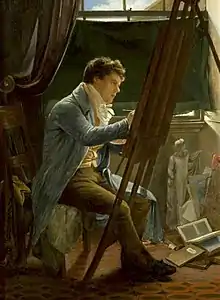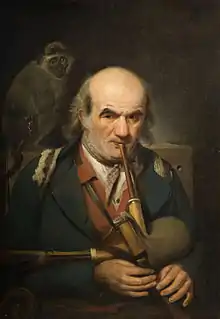Edward Bird
Edward Bird RA (1772 – 2 November 1819) was an English genre painter who spent most of his working life in Bristol, where the Bristol School of artists formed around him.[1] He enjoyed a few years of popularity in London, where he challenged the dominance of Sir David Wilkie in the genre painting field, before moving on to history painting, specialising in battle scenes.
Edward Bird | |
|---|---|
 Edward Bird by Edward Villiers Rippingille, 1817 | |
| Born | 1772 |
| Died | 2 November 1819 |
| Nationality | English |
| Known for | Genre painting, History painting |
Early years
Bird was born in Wolverhampton, the son of a carpenter. He received no formal artistic training, but developed his skills through apprenticeship as a japanning artist painting tea trays. In 1794 he moved to Bristol, where he married Martha Dodrell and pursued a career in artistic commissions: portraiture, book illustrations, and church painting.
Bristol School
At Bristol, Bird became the centre of an informal group which included other artists such as Edward Villiers Rippingille and Nathan Cooper Branwhite, and which developed into the Bristol School.[1] Initially amateur artists dominated the group, and Bird's closest friends included the amateurs John King, who was also Bird's doctor, and George Cumberland.[2] Cumberland, who moved to Bristol in 1807, became godfather to Bird's son.[3] He had a large art collection from which he would lend items for Bird to study.[2]
The group conducted evening sketching meetings and sketching excursions to scenic locations around Bristol.[1] Landscape with Cottage was probably painted on one of these trips. However, Bird painted landscapes relatively infrequently and he would often accompany the excursions without joining in the sketching.[4] Bird's greatest influence on the Bristol artists was in the naturalistic style and fresh colours of his genre painting, especially so in the case of Rippingille, who worked closely with him.[5] In 1814 they both exhibited works at the Royal Academy with the same subject, The Cheat Detected.[6] Francis Danby, who moved to Bristol from Ireland in 1813 and was to succeed Bird as a leader of the Bristol School,[7] was also influenced by Bird's genre style.[6][8]
Success

In 1809, he exhibited at the Royal Academy Good News, a genre portrait of an old soldier. Placed next to Wilkie's The Cut Finger, it attracted attention, and Bird's popularity grew when the Prince Regent bought his The Country Choristers and commissioned Blind Man's Buff. His works also include the Field of Chevy Chase and the Day after the Battle, which was pronounced his masterpiece.
Bird was elected an associate of the Royal Academy in 1812, was appointed historical painter to Princess Charlotte in 1813, and elected a full member in 1815.
Plagued by ill-health for over five years and unable to paint in the last year of his life, Bird died on 2 November 1819. He was buried in Bristol Cathedral.[5] The following year a successful retrospective exhibition of his work was shown at the Bristol Fire Office, for the benefit of his family. His son George later became a midshipman, his equipment paid for by the subscriptions of Bird's friends. His daughter Martha became a Bristol watercolourist, and the younger daughter Harriet a governess.[9]
References
- Greenacre, Francis (1973). The Bristol School of Artists: Francis Danby and Painting in Bristol 1810–1840 (exhibition catalogue). Bristol: City Art Gallery, Bristol. pp. 9–14.
- Richardson, Sarah (1982). Edward Bird (exhibition catalogue). Wolverhampton: Wolverhampton Art Gallery. pp. 5–7.
- Greenacre, Francis (2004). "Cumberland, George (1754–1848)". In Matthew, H.C.G.; Harrison, Brian (eds.). Oxford Dictionary of National Biography. 14. Oxford University Press. pp. 614–615. ISBN 0-19-861364-4.
- Richardson, Sarah (1982). Edward Bird (exhibition catalogue). Wolverhampton: Wolverhampton Art Gallery. pp. 11–12.
- Greenacre, Francis (1973). The Bristol School of Artists: Francis Danby and Painting in Bristol 1810–1840 (exhibition catalogue). Bristol: City Art Gallery, Bristol. pp. 105–107.
- Richardson, Sarah (1982). Edward Bird (exhibition catalogue). Wolverhampton: Wolverhampton Art Gallery. pp. 18–22.
- Adams, Eric (1973). Francis Danby: Varieties of Poetic Landscape. London: Yale University Press. pp. 4, 11–13. ISBN 0-300-01538-0.
- Greenacre, Francis (1988). Francis Danby 1793–1861. London: Tate Gallery. p. 13. ISBN 1-85437-000-6.
- Richardson, Sarah (1982). Edward Bird (exhibition catalogue). Wolverhampton: Wolverhampton Art Gallery. pp. 43–44.
Further reading
- Francis Greenacre, "Bird, Edward (1772–1819)", Oxford Dictionary of National Biography, Oxford University Press, 2004 accessed 1 July 2007
- London. Edward Bird at the Geffrye Museum, Nicholas Alfrey, The Burlington Magazine, Vol. 124, No. 951 (Jun. 1982), p. 372+375+377
External links
| Wikimedia Commons has media related to Edward Bird. |
- 51 paintings by or after Edward Bird at the Art UK site
- Arrival of Louis XVIII at Calais
- The Battle of Chevy Chase
- Italian Dancing Dog Master
- Bristol City Museum and Art Gallery
- Profile on Royal Academy of Arts Collections
This article incorporates text from a publication now in the public domain: Wood, James, ed. (1907). The Nuttall Encyclopædia. London and New York: Frederick Warne. Missing or empty |title= (help)